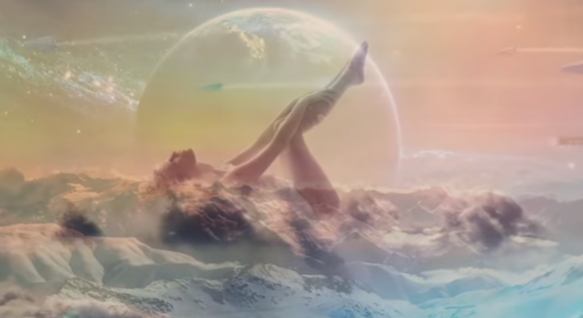(单词翻译:单击)
We all spend roughly a third of our lives asleep,
我们一生有大约三分之一的时间都在睡觉,
accessing dream worlds in our subconscious that are lost by the time we wake up.
进入潜意识中的梦境,而这些梦境在我们醒来时已经消失了。
But what if they didn’t have to be?
但假如它们不必在我们醒来时就消失呢?
What about if we could modify sleep stages, or how about if we could guide dreams?
假如我们可以调整睡眠阶段,引导梦境呢?
Improving our well-being, using it for learning, or solve, things like biases or anxieties...
用来增强我们的幸福感,用来学习或解决偏见或焦虑之类的问题呢……
so how can we create technologies that can deal with that?
问题是,我们怎样才能创造出能够解决这个问题的技术。
Judith Amores and the engineers, neuroscientists, and designers she works with at MIT’s media lab, dubbed "the dream team"
(事实上)麻省理工学院媒体实验室的朱迪思·阿莫斯和她的工程师、神经科学家和设计师同事,又名“梦之队”,
are working to decode the unconscious mind.
就已经在努力解码我们的潜意识了。
But these are no ordinary sleep scientists.
但他们并不是普通的睡眠科学家。
They don’t just want to understand the role that sleep and dreams can play in our lives;
他们想研究的也不止是睡眠和梦在我们生活中扮演的角色;
they think we can actually tinker with it.
他们认为,我们是可以修补我们的梦境的。
Dreams are kind of our own virtual reality.
梦境也可以说成是一种虚拟现实。
It's very interesting how some people have been applying that for thinking of their traumas or phobias,
有趣的是,有些人就是用梦来思考他们的创伤或恐惧症的,
because you can actually fight against those in a dream,
因为你是可以在梦中与这些问题对抗的,
because you know it's not real, but still it's having an effect on you.
因为你知道梦(虽然)不是真的,但还是能影响到我们。
Sleep has long been recognized not only for being therapeutic, but also a source of inspiration.
长期以来,人们都认为睡眠不仅具有治疗作用,也是灵感的来源。
Visionaries like Nikola Tesla have used hypnagogia, the state of being half asleep,
尼古拉·特斯拉等颇有远见之人就曾利用“半梦半醒”,也即半睡眠的状态,
to doze their way to some of the world’s most iconic art and inventions.
在似睡非睡之际创作出世界上最具标志性的艺术和发明。
Hypnagogia has been associated to creativity and also problem solving.
人们将“半梦半醒”和创造力,解决问题联系到了一起。
For example, Salvador Dali used to have these crazy surrealism paintings, beautiful.
比如,萨尔瓦多·达利曾经画过这种疯狂的超现实主义画作,确实很漂亮。
So he actually used this state as an inspiration.
而他就是用这个状态作为灵感来源的。
Thomas Edison as well.
托马斯·爱迪生也不例外。
I think the song "Yesterday" by the Beatles was also created in a dream.
而且,再我看来,披头士的那首《昨天》也是在梦里创作出来的。

To harness this potential,
为了利用这种潜力,
The dream team is exploring the world of ‘human-machine symbiosis...’
“梦之队”正在对“人机共生”的世界——
that is, designing technology intended for seamless integration into your life...and your body.
也就是设计出旨在无缝融入您的生活……和你的身体的技术的世界——展开探索。
And if that sounds straight out of sci-fi…It is.
觉得这听起来很科幻?科幻就对了。
The dream team recently debuted dormio, a glove designed to boost creativity.
该研究团队最近推出了“多米奥”——一款旨在激发创造力的手套。
Dormio recognizes a hypnagogic state,
“多米奥”能够识别半睡半醒的状态,
triggers a robotic voice to read you an audio cue or creative prompt in your sleep, and records your mumbled response.
在你入睡后触发机械的声音,给你读一段音频提示或激发你创造力的提示,然后记录下你含糊不清的回应。
It started as a, actually as a glove,
一开始它就是个手套,
like a quick hack with a capacitive sensor that would detect when you're falling into hypnagogia.
类似于带有电容式传感器,能够检测出你什么时候进入半睡半醒状态的一个快速检测装置。
Then they added more sensors to really make it more accurate, and more beautiful as well.
后来,他们给它增加了更多的传感器,使其变得更精确也更漂亮。
So it was not like a glove anymore,
这时,它就已经不再像个手套,
but it was more like a really cool, kind of sci-fi, neon-style, finger-worn device.
而是更接近于一个非常酷,有点科幻又有点儿霓虹灯风格,只需要戴在手指上的设备了。
But what about our sleep states beyond hypnagogia?
但除了半睡半醒,我们剩下的睡眠时间(能不能加以调控)呢?
The dream team is developing additional prototypes to analyze even more of your body’s biological cues.
“梦之队”也已经在研发能够分析人体更多的生物信息的模型了。
A deep learning computer model then deciphers this information to determine what stage of sleep a person is in.
之后,深度学习的计算机模型会破译这些信息,确定一个人处于睡眠的哪个阶段。
So REM is R-E-M, which is Rapid Eye Movement.
REM,也就是R-E-M,快速眼动睡眠。
And then, that's the typical one where you have vivid dreams, like movie kind of dreams.
也就是典型的那种梦境特别真实,就像电影一样的梦的阶段。
You can actually be aware that that's a dream,
你甚至能够意识到你是在做梦,
and then it's what some people call "lucid dreaming."
再然后就是某些人所谓的“清醒梦”阶段。
The non-REM, we can separate that into three sleep states: N1, N2 and N3.
我们可以将非快速眼动睡眠阶段进一步细分为N1,N2,N3三种阶段。
N3 is particularly one that I'm very interested in because it's associated with memory consolidation.
我尤其感兴趣的是N3这个阶段,因为它与记忆加强有关。


